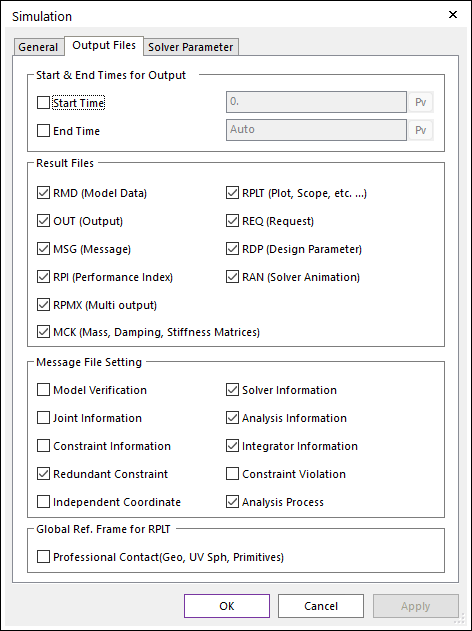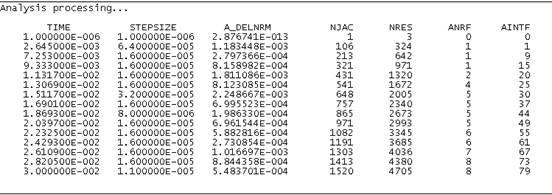3.5.7.2. Output Files Page
This page allows the user to control the output files after the simulation.

Figure 3.96 Simulation dialog box [Output Files]
Start & End Times for Output: Defines the time range of the plot results. For example, if the user defines the range as the start time with 1 and the end time with 2, RecurDyn reports the plot results from 1 sec to 2 sec after the simulation.
Start Time: Defines the start time of plot results.
End Time: Defines the end time of plot results.
Result Files: If the user checks these options, RecurDyn creates the following result files.
Table 3.1 Result File List File Name
File Format
Created by
Contents
RMD (ModelData)
Text
RecurDyn/Modeler
All of the model data that are used by RecurDyn/Solver to run a simulation.
RPLT(Plot,Scope, etc…)
Binary
RecurDyn/Solver
Result data for Plot and Scope.
OUT(Output)
Text
RecurDyn/Solver
Initial conditions and eigen outputs.
Creation of the mck.m file is also determined by this option.
REQ(Request)
Text
RecurDyn/Solver
Result data about defined requests.
MSG(Message)
Text
RecurDyn/Solver
A solver message.
RDP(DesignParameter)
Text
RecurDyn/Modeler
Design parameters for performing Parametric Study.
RPI(PerformanceIndex)
Text
RecurDyn/Modeler
Result data about the performance indexes for performing Parametric Study.
RAN(Solver-GeneratedAnimation)
Binary
RecurDyn/Solver
An animation result. The animation flag can be activated by this file. In case of the standalone solver, the RAD file does not exist because there is no RecurDyn/Modeler. Therefore, the RAN file should be created the animation results. Additionally, when importing the RAN file, the RPLT file related to the RAN file is imported automatically.
RPMX(MultiOutput)
Text (XML)
RecurDyn/Solver
This file has solver commands with the path of animation result files.
If the user wants to simulate multi-analysis using the scenario analysis, which helps to check the animation results. It needs that RAN file creation the option must be checked.
Additional Result Files: If the simulation is started, RecurDyn creates the following result files. The user could not control whether or not to create these files.
Table 3.2 Additional Result File List FileName
File Format
Created by
Contents
DAT
Text
RecurDyn/Solver
Result data of the converting a file to read in RecurDyn/Solver from the RMD file. (After performing the simulation successfully, it is deleted at the end of simulation.)
DBK
Binary
RecurDyn/Solver
All body data of the converting a file to read in RecurDyn/Solver from the RMD file. (After performing the simulation successfully, it is deleted at the end of simulation.)
INF
Text
RecurDyn/Solver
Input debug information for RecurDyn/Solver. (After performing the simulation successfully, it is deleted at the end of simulation.)
LOG
Text
RecurDyn/Solver
The solver version information and additional solver information.
FPLT
Binary
RecurDyn/Solver
Result data for Plot after performing a Frequency Response Analysis. To see the FPLT file, the FRA Plot function should be used.
FRQ
Text
RecurDyn/Solver
Eigenvalues.
FCP
Binary
RecurDyn/Solver
The contacted patch information and the contact pressure. This file is used to see the Contour result.
GSTRN
Binary
RecurDyn/Solver
Plastic strains at gauss points. This file is used for calculating plastic strains.
GSTRS
Binary
RecurDyn/Solver
Plastic stresses at gauss points. This file is used for calculating plastic stresses.
MMX
Binary
RecurDyn/Solver
The minimum and maximum values of stress and strain of RFlex and FFlex bodies for each time step. This file is used to see the Contour result.
MCK (Mass, Damping, StiffnessMatrix)
Text
RecurDyn/Solver
This file has Mass, Damping, and Stiffness matrices of the system including Rigid and RFlex bodies. If one of Eigenvalue, FRA, and Statematrix analysis is used, then the _mck.m file is created.
Message File Settings: If the user checks these options, RecurDyn/Solver writes the following information in the MSG (Message) file.
Model Verification

Joint Information

Constraint Information

Redundant Constraint

Independent Coordinate

Solver Information

Analysis Information

Integration Information

Information of starting time

Constraint Violation

Analysis Process

A_DELNRM: The Accumulated Total Norm
NJAC: The Total Number of Jacobian Evaluations
NRES: The Total Number of Residual Evaluations
ANRF: The Accumulated Total Number of Newton Raphson Failures (The Maximum Iteration is 10 in RecurDyn.)
AINF: The Accumulated Total Number of Integration Failures (During the Newton-Rhapson Iterations, if the total norm of the current step is greater than that of the previous step, RD counts this case as the number of Integration Failure.)
Global Reference Frame for RPLT: If the user checks this option, then the reference frame is set to the Ground.Inertia Marker for the plot data on the RPLT file.
Professional Contact (Geo, UV Sph, Primitives): If the user checks this option, then the summation contact force plot data is calculated with respect to the Ground.Inertia Marker for primitive contacts, UV Sphere contact, and Geo contacts.